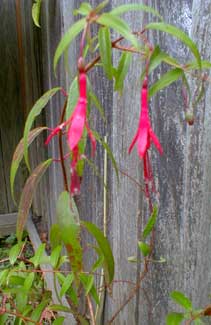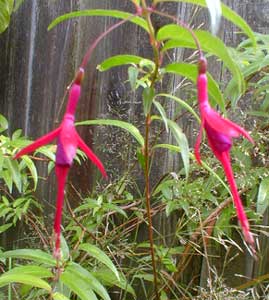
Vining Fuchsia
"Up shadowy long-forgotten bowers
Of sculptured ivy and stone flowers,
Up many & many a marvellous shrine
Whose wreathed friezes intertwine
The viol, the violet, & the vine."
-Edgar Allan Poe
(1809-1849)
(1809-1849)
There are several variants & subspecies of this botanical fuchsia. Ours is the basic Fuchsia regia ssp regia, which has the strongest vining tendency & is one of the largest varieties within the species. It is capable of wending its way to twenty feet & is notably vigorious. Other subspecies are smaller & most do not vine.
The vining fuchsia is one of the least suited to hanging pots because it will become leggy in search of places to cling. But it does exceedingly well as a hardy garden plant trained to a fence or trellis.
Ours grows against a fence not too distant from a Kiwi Vine & a Weeping White Birch, the whole area requiring deep watering in summer.
 The species was formerly known by the synonyms F. integrifolia, & F. pyrifolia, besides the various subspecies having at times been listed as their own species.
The species was formerly known by the synonyms F. integrifolia, & F. pyrifolia, besides the various subspecies having at times been listed as their own species.This Brazillian native wildflower is fully hardy here in the Pacific Northwest. It wants rich, moist soil &, in the Northwest, a goodly portion of sunlight, though it wants increasing amounts of shade the further south it is grown.
Its one fault, if it is a fault, is how it has a tendency to find the nearest trees & shrubs to climb up & through. So it requires attention & training to a trellis or other support. It is also the opposite of compact, with its leaves & flowers thinly dispersed along along th lengthy vining stems. The leaves are lance-shaped, almost leathery in appearance, with red veins, much tougher appearing than on other fuchsias.
First described in 1829, it has been gardened in Europe since the 1840s. By the 1850s it was already being used in what was to become increasingly elaborate hybridization programs. The fully wild vining form has taken a back seat to the hybrids, but is still a choice that might be preferred for any naturalistic woodland gardening scheme.
On Puget Sound it is semi-evergreen to the end of winter. It waits until January before leaves get spotty & many begin to fall. It can be a little slow to regain new foliage; in our garden it is good & leafy again at mid to late May, & can flower shortly thereafter but in some years doesn't bloom much until mid summer or later, flowering most strongly in autumn. The flowers on this page are shown in October (2003) & late September (2004).
The summer flowers persist long into autumn, with even an odd occasional bloom in early winter. These are small basic "wild" fuchsia flowers, with red tube & sepals, & purple corolla.